Okay, so you’ve been grinding away… you’ve got a tonne of podcast episodes released… you think your audience is listening because you do see a few downloads for every episode. This makes you happy, but nervous at the same time. It makes you wonder ‘why am I even doing this?’.
If only your efforts could start paying off dividends, and maybe your hustle can start making you money. So, fear not, in this guide, I break down how you can actually turn your podcast into a fully fledged money making machine.
Do Podcasts Make Money?
Chapter 1
Maybe the question isn’t do ‘podcasts make money’, but can you make money from podcasts? I’ll get to that a bit later. For now, monetizing podcasts isn’t anything new. In fact, you may already know that Spotify offered Joe Rogan a $100 million to sign and exclusive with them, making him one of the highest paid podcasters in the world. The deal is one the largest known ones in the podcast industry.
And… he’s not the only one to make some serious dough. There are plenty of others.
Vox Media is a media company that creates, publishes, and distributes online content, and connects young adults worldwide. It now has more than 200 active podcasts that it publishes through the Vox Podcast Network, up from 75 in January 2020, netting the podcast publishing division just over $185 Million in revenues.
So, it’s no surprise that podcasts is serious business with serious money. Here are the top 5 highest paid podcasters that are known publicly:
#1 – The Joe Rogan Experience Podcast
Joe Rogan gets over 9 million people regularly listen to The Joe Rogan Experience Podcast, and he’s claimed that over 190 million people download his content per month. At the time of writing this he’s on 1628th episode! That’s a lot of talking.
His podcast has notable celebrity guests include Matthew McConaughey, Elon Musk, and Mike Tyson. Granted, his celebrity status and past experience in the entertainment industry has helped him gain traction quickly. But his style, in-depth and some controversial conversations no-doubt have helped him find success in his career.
It’s estimated that his podcasts earn him around $75,000 per episode, over $800,000 per month. This doesn’t even include any additional revenues he’d collect from YouTube.
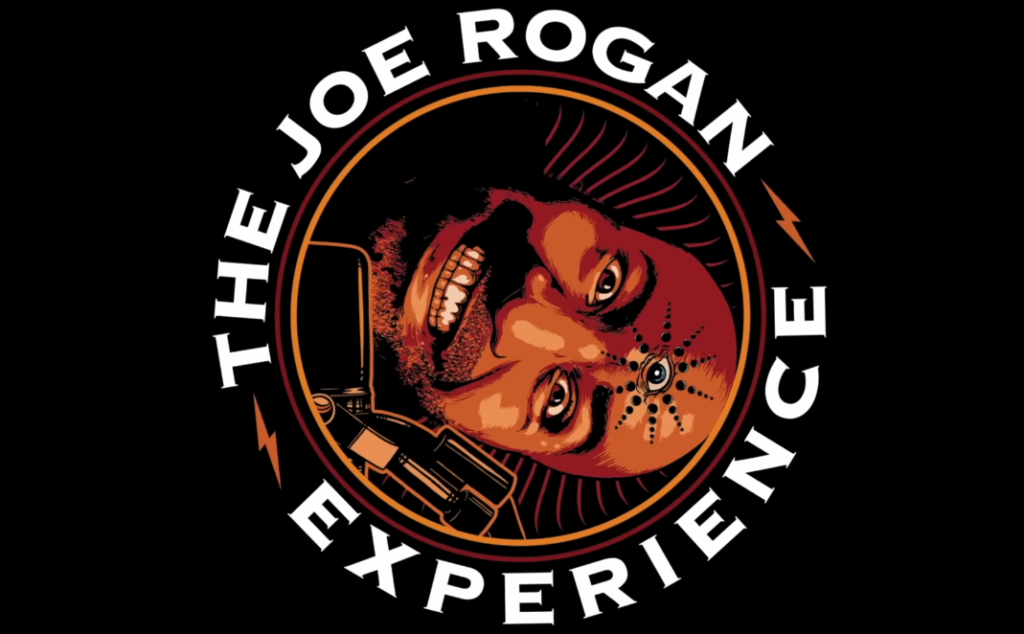
Key lesson from Joe Rogan: Pick your guests wisely – not everyone is suitable for your podcast. So take your time to research your guests, find those that you can have meaningful conversations with, and will resonate with your audience.
#2 – Chapo Trap House
Chapo Trap House is a political podcast combined with wit and humor. It’s hosted by Will Menaker, Matt Christman, Felix Biederman, Amber A’Lee Frost, and Virgil Texas. With the first episodes out in 2016, it hasn’t done too bad – especially given over 35,000 people listen to it. It’s estimated they make over $150,000 per month. Interestingly the podcast on YouTube is nearing 100,000 subscribers to the channel.
The podcast takes current political topics and combines them with humour. It’s a hit for people who want to stay current and discuss important issues but can’t stand the dryness of political news.
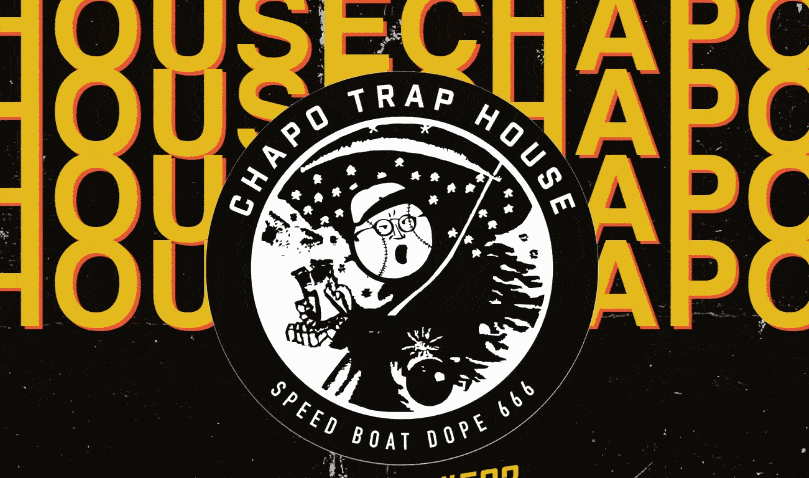
Key lesson from Chapo Trap House: Got some strong opinions? Podcasting is a great way to express them and stick to your views. You’ll get haters. But you’ll also be authentic and that’s what your listeners really want. The other lesson is timing – with so much political unrest in the US recently, it’s no wonder why audiences resonated with the podcast quickly.
#3 – Smart Passive Income
Pat Flynn’s podcast Smart Passive Income– as the name suggests goes into the ways that listeners can make passive income. It’s clearly targeted at entrepreneurs and those that want to become one.
Starting off as a speaker before this, Pat’s podcast started to get some traction back in 2013 and now he’s surpassed 400 episodes. Unlike the other two mentioned earlier, he’s clearly finding success even posting a much lower episode count.
Pat’s podcasts make a whopping $100,000 per month. He attributes to three key ways that have helped him make money from podcasting:
- Affiliate marketing
- Promoting his own product
- Advertising/Sponsorships which have helped him generate over $350,000 in revenues.
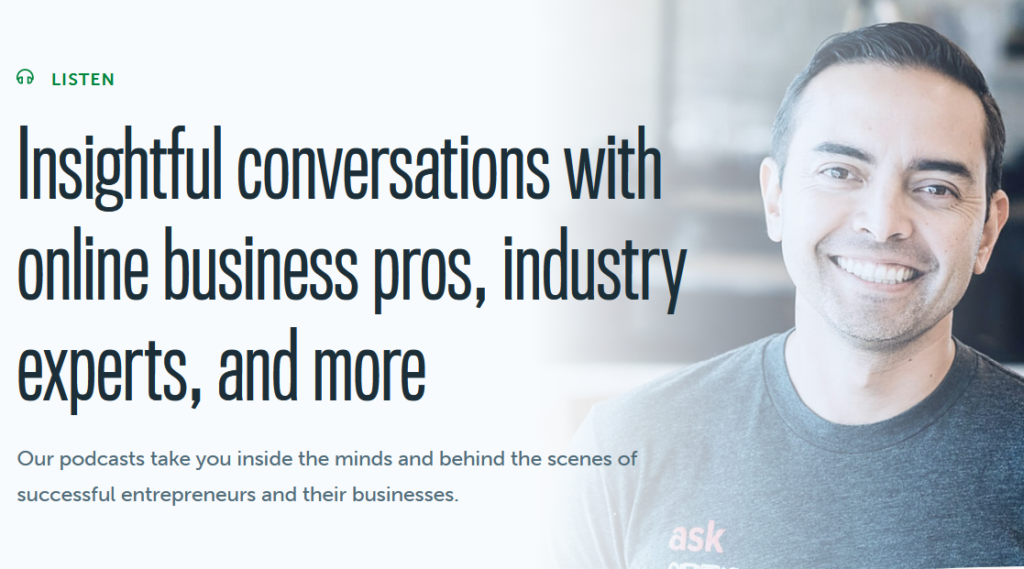
#4 – Last Podcast on The Left
Hosts Ben Kissel, Henry Zebrowski, and Markus Parks have found great success through story telling. Their show Last Podcast on The Left features horror stories, discussions around the paranormal, aliens and occult topics.The show has over 510 episodes, and their fan base is almost 12,000 regular listeners. With their sponsorships, live shows, and merch, the group earns about $55,000 per month.
If you look on their website, they’ve covered off a lot of ways to make money from their podcast. Examples include:
- Patreon
- Tours
- Merchandise

One Lesson from Last Podcast on The Left: Entertaining your audience is one heck of a way to hook your audience and keep them coming back to you. Storytelling, music, comedy are just a handful of ways to entertain your audience. But even if you have a business podcast, you should try to educate or entertain.
#5 – Tiny Meat Gang
Tiny Meat Gang is a light hearted comedy based podcast run by two social media (vine and youtube) comedians Cody Ko and Noel Miller. The podcast takes current stories and discusses them with a comedic spin, going through funny stories, opinions, and gossip. They’ve created over 180 episodes, and have regularly ranked #1 on Apple and Spotify.
Tiny Meat Gang make an average of $51,000 per month for their podcasting.
Tiny Meat Gang podcast generates significant revenues from affiliate marketing. Their affiliate partners are evident by taking a quick look at their descriptions – see the image. Remember, with growing publicity, the duo makes more revenues from tours and live gigs.
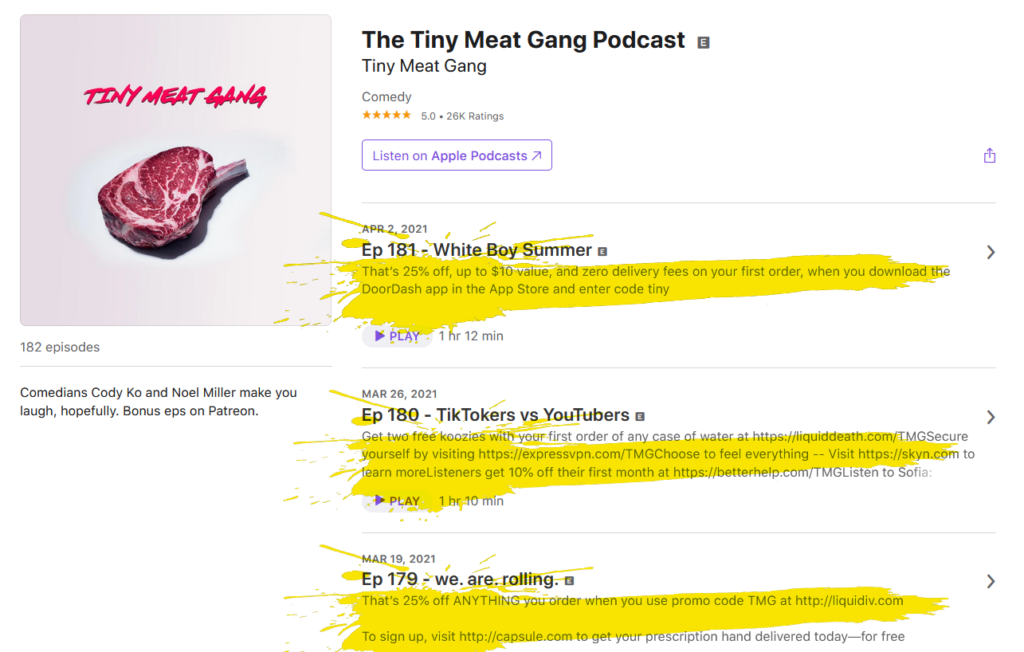
What Does it Take to Really Make Money From Podcasting?
Chapter 2
The above podcast monetization numbers are all good for the top percentile of podcast creators. But what about for the rest of us meager folks?
The good news is, it’s not impossible. Even the above mentioned names didn’t just get lucky. They focused on quality, engaging and entertaining their audience, and providing value to their listeners. So, if you’re ready to put in the hard yards, then here’s the path to making money from podcasting:
Rule #4 Explained. Deliver real value to your audience.
What can you do to add value to your audience?
Pick topics and themes that your audience just wants to come back to – not just because they’re interesting, but because there is a take-away.
Simply put: entertain, engage or entertain your audience.
Here are a few questions that will help you identify topics and discussion points for your podcast that will add value to your audience.

10 Ways To Make Money From Podcasting
Chapter 3
There are a several ways podcasts make money.
Let’s go through some ways you can use podcasts to make money❓
#1. Ad Impressions from the Streaming Service
The obvious method to monetizing your podcast is Ad impressions. A CPM is (Cost per thousand impressions) is a common metric used by media buyers in advertising. In the case of podcasts, impressions are measured by downloads– more specifically – downloads that contain an ad.
A sponsor will pay you a certain amount for every thousand downloads that you have for your podcast.
Companies like Midroll match advertisers with your show. You keep control: You decide how many ads your show will have, and you approve the advertisers. Having said that, they wanna see some big numbers.

The one that’s easiest for newcomers would be to have your host site help you find the advertising. Hosting sites like Podbean offer features like an ads marketplace, where you can opt in to the service and have the ads inserted automatically within your podcast. Although there are no upfront costs – they will typically charge a cut of the ad revenue that your podcast earns. Better than paying money out of your pocket though!

The hosting service will place ads at the start or at the end of the episode. Podbean lets you set time slots too giving you bit for flexibility on where the ad is inserted.
Want to do more with your video podcasts? Use the Video to text converter to transcribe your podcasts and even edit them using text!
#2. Ad Impressions through Sponsorships
Okay, so the hosting service probably won’t cut it if your download numbers are a little low.
So, it might be time to roll your sleeves up and hunt down sponsors directly.
Sponsorships are a slightly more attractive option for content creators to monetize their podcast over standard ad-impressions. A number of variables could help you attract larger deals – even with less impressions.
Many sponsors do want to see at least 5K – 10K downloads per episode before they’ll start working with you, but if you serve a highly-targeted niche audience, you can probably get deals with less than that amount of impressions.
Affiliate Sponsorships
Instead of paying for impressions (or download) basis, you can setup an affiliate structure. In this case the sponsor will pay you a fixed amount or percentage for customer acquisition (CPA). This could be purchases or sign ups that you directly help drive for your sponsor.
For example a CPA of $1, means the sponsor will pay you a dollar for every sign up or purchase that your audience makes. An affiliate commission is result driven. It can a more effective option to make money if your audience matches that of the sponsor.
It’s easier for sponsors to pay commission from sales (CPA), than paying fixed amounts for downloads (CPM) so, if you want to pitch to sponsors, then a CPA option may be the easier one to go with for now.
Buzzsprout recently added an affiliate marketplace to make it as easy as possible to make money with your show

How To Get Sponsors For A Podcast
There are 3 ways you can find a sponsor:
- Either your sponsor will find you – if you’re lucky or growing fast enough
- You can do an outreach campaign to find, pitch and land sponsors – this means actually pitching your podcast to various businesses. Like any outreach, consider how the prospect business will benefit.
- Some hosting services (like BuzzSprout) have an affiliate marketplace service
Obviously businesses are looking to make money and grow their own audiences. So this should be the biggest benefit you offer – so, it naturally means that you need to have a significant audience size (or a smaller, but highly targeted audience) of your own.
You should aim to have a minimum of 500-1,000 downloads per episode to start creating money making opportunities from podcast sponsorships. Remember your future sponsor (or media buyer) is getting pitched all the time though, so you should aim to at least have numbers in the range of 5,000 plus to get any attention at all.
How Much Money Can You Make From Podcast Sponsorships?
Standard CPM rates for podcasts would be $15-25 for every 1,000 listeners. If you were to do weekly episodes and you got 1,000 downloads per episode, you’d be looking at (a not so whopping) $60-$100 per month.
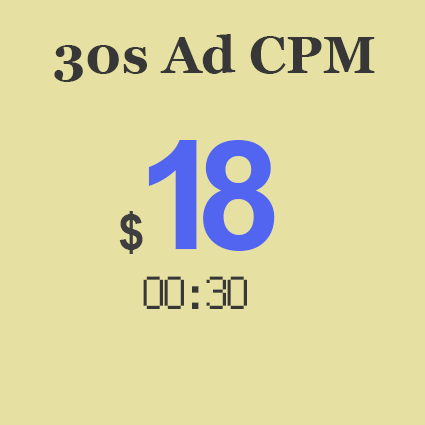
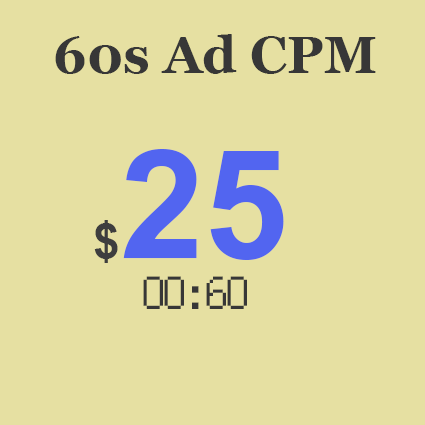
Having said that, this is not a hard rule. There are no industry standards for CPA only industry averages. According to AdvertiseCast, the average rates for podcast CPM advertising are $15 for a 10-second ad, $18 for a 30-second ad CPM and $25 for a 60-second ad CPM.
Nothing to live off – but enough to start paying some bills and putting money towards better equipment, software or support to help you create more content! Once you pass 10,000 downloads per episode, then you’ll start to see some real money coming in from sponsors.
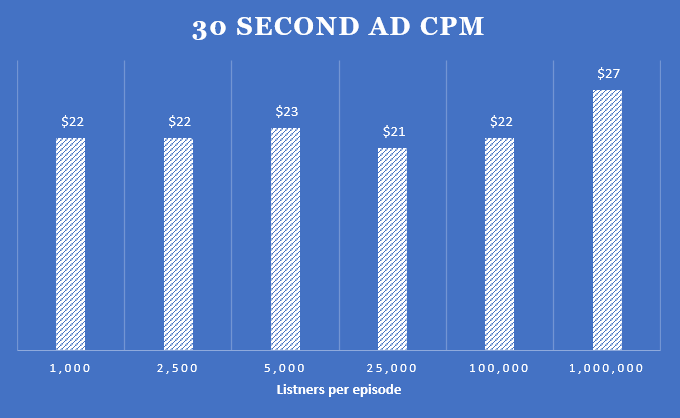
How can you make more than the industry average?
In advertising, be it for print, broadcast or online, or in this case podcast, an advertiser is paying not simply to reach a wide audience, but more importantly to reach the right audience. The advertiser will try to find podcasts with audience demographics that are a good match for their product or services.
The following will help determine how much money you can make from sponsorships:
🎙 quality of your podcast
🎙 quality of your audience
🎙 quality of your pitch!
From a media buyers perspective paying 10 – 30% commission plus other benefits (like free use of product or discounted services for yourself) is fairly common. So think about it little – especially if you have a niche audience. The right message to the right audience attracts better conversions for media buyers, and they may opt to pay you higher rates – if you can show this to your sponsor.
#3 Sell Merchandise
Shirts, Mugs, Hoodies, Water Bottles.. there’s a lot of merchandise you can offer your fans that can help build a revenue stream.
As a podcast, how do you offer merchandise to your listeners?
#1 Print your merchandise
Okay, so you don’t need to buy the equipment and print your own t-shirts! You can actually use any number of print-on-demand services. A simple search in Google will reveal a tonne of options for you to choose from!

#2 Set up your e-commerce
You’ll need a way for customers to select and buy your merchandise.
- Through your WordPress website – adding e-commerce capabilities to your WordPress site isn’t too hard. If you’ve set up your site on your own, then you shouldn’t have issues with adding this on. You can hire someone to add something like Woo-commerce for you, then hook it up to your payment processor (e.g. Stripe or PayPal). The pro is, it is in your complete control, including the branding.
- Shopify – this requires even less work than WordPress however expect to pay a monthly subscription fee to Shopify. Custom branding options are available as well as several plugins or add-ons that help make it easier for you to manage your Shopify store.
- E-bay – the cheapest option as there are no upfront costs but offers minimal branding and control.
#3 Promote your merchandise
Remember to let your listeners know about your merchandise. If you’re doing video podcasts as part of your content marketing, then a clear give-away is you wearing and showing your merchandise! But you may want to actively promote it on your marketing channels as well as mentioning it to your listeners every now and then.
#4 Sell Products and Services
You can take it one step further than selling merchandise. How about selling products or services. These can either compliment your podcast or fall under the theme of your podcast. If you’re doing this, well then you’re essentially an entrepreneur – welcome to the club!
I’m not going to go into the topic of how to create and sell products and services – for obvious reasons. If you haven’t thought about selling any before though, then I’d urge you to atleast consider brainstorming ideas for now so that it can become a possible reality in the near future.
- Your own Book
- E-books
- Courses
- Software
- Tools or Templates
Pro Tip: Instead of promoting your product or service directly, why not bring your customers on the show and get them to talk about the success your product or service helped them get!
#5 Use YouTube
When you think podcast you also think video… well… I do anyway. As a listener I actually don’t mind ‘listening’, rather ‘watching’ my podcasts. To actually see the podcast host in a video interview creates a different sort of experience – for me personally.
Read: The Complete Guide to Video Content Marketing
Although podcasts are great for tuning into when on-the go, but when I’m sitting down or just a passenger on the train, I love to have something visual to look at. Having said that, I’m not the only one.
YouTube has over 2 Billion logged in users monthly. That’s a lot of eyes…. and ears. That’s not even considering the videos that are watched without logging in to the platform.

What I’m saying is, there’s a huge audience that hangs out on YouTube alone, the question is do you want a piece of that pie? Even a tiny piece can boost your own audience, that will help you make more money through your podcast.
Not only that, but influencers are using YouTube to make a bucket load of money as well. Maybe creating vlogs could be something to take up?
#6 Charge Guests
I’m hesitant to put this hear, but hey, it’s an (controversial) option. It will only really work if you can provide immense value to your guest, this would mean you have a community your guest really wants to get in front of, you have a brand your guest wants to utilize, etc.
In this case, it’s really up to you to charge whatever your guests are willing to pay. Most podcasters don’t charge their guests as it only limits the number of guests you’ll be able to get on your show – unless that’s your goal!
#7 Ask for Donations
Donations are a great way for your fans to reward you for your effort and the value that you provide. Loyal fans and supporters will happily pay – as long as you have a pretty good podcast. There’s no harm in asking for donations.
Using Patreon
Setting up a Patreon account is similar to setting up a membership area for your listeners. Patreon allows you as the creator to provide your audience with exclusive content as incentives, based on the amount donated. Levels or tiers based on monetary value are created, and certain rewards or incentives are linked to each level. The more a person donates, the more exclusive content or rewards they will have access to.
Using PayPal
Paypal gives you flexible payment acceptance solutions (if you are using PayPal already for selling your own products, services or merchandise, then it’s easy to just put a donate button next to your episodes). You can also put a link in the description of your podcasts so that podcast listeners don’t need to find it through your website alone.
If you’re not already using PayPal then simply set up a PayPal account, get your unique link, and donate button, which allows listeners to easily donate to you with the click of a button. Payments can be one time only or even on a recurring basis. It is free to get started and there’s no monthly fee, but they receive a percentage per transaction.
Oh! And don’t forget to ask for donations in your podcast. It’s ok to nudge or remind your listeners every now and then – just don’t go over board with it!
#8 Create Paid Membership
Doesn’t have to be new content. You could close off older content that ads more value to users. There are a few ways you can close off content and make it premium:
- Bonus content
- VIP interviews
- Ad-free content
- Question and Answers
- Special events
We already touched on Patreon above to create a membership option for your listeners. You can also use WordPress as it gives you complete control of your website, as well as membership plugins such as, but not limited to:
For podcast creators though you can also choose a more specific solution to create membership areas. Supercast is another option and it lets you create Subscriptions for your podcast as well as combine or add-on ad revenue.
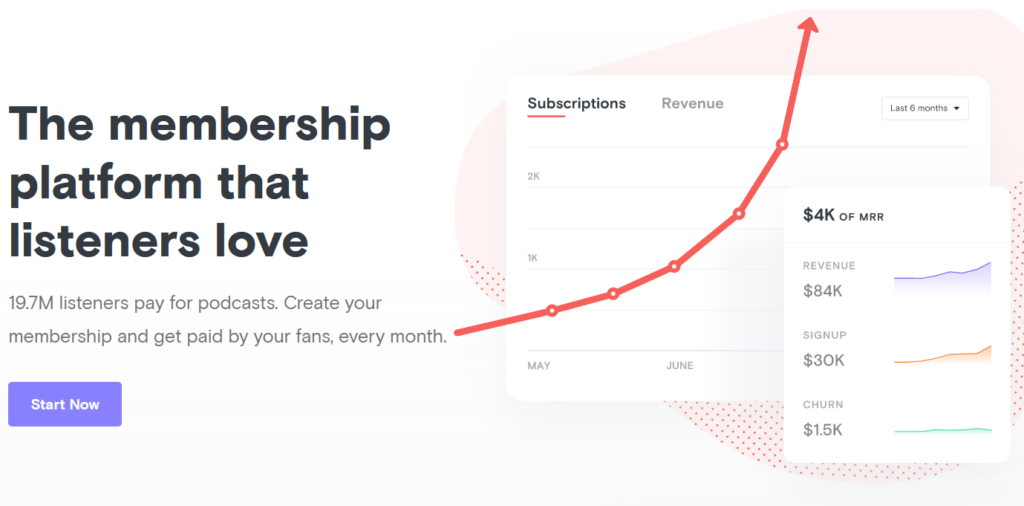
#9 Become a Public Speaker
Why just talk in a studio when you can spread your expertise live, in public? According to HBR, public speaking is nothing to laugh at. Here are some rates that public speakers can get paid:

- Newbie speakers might earn $500–$2,500 for a talk.
- Beginning speakers, or those just establishing a brand with their first book, might earn $5,000–$10,000.
- Those with several books and other forms of “social proof” might draw $10,000–$20,000.
- Those who are very well-known in their field, such as best-selling authors, can bring in $20,000–$35,000 per talk.
Public speaking attracts more than just money though – brand recognition which can help fuel your other channels.
#10 Use Other Social Media
The great little thing about podcasts is the extensive amount of content you have at your disposal. By converting this content to other mediums, you could achieve these outcomes:
- Grow your audience on other channels so you have a diverse base of fans
- Refer traffic from other channels to your podcast
- Possibly monetize other channels
- Attract sponsorship opportunities
Besides YouTube as we talked about earlier, platforms like TikTok, LinkedIn and Facebook pay for your content too (through add impressions primarily). On the other hand businesses and media buyers are always on the look out for influencers. So, say you don’t have enough listeners to your podcast, but you garner a large audience on other channels, this could open you up to sponsorships, gigs, or other opportunities.
Keep in mind though, that it’s not that easy getting on all different channels. For example, if you think about getting onto Instagram, just consider this… they so far have:
Instagram TV (IGTV), Reels, Instagram Stories, Carousels…. so on and on… and on. Now imagine learning how to get the best out of each of these, which one do you start with? what will work for your specific content, personality or skill set? what is in fact even feasible for you to create? There’s a lot to think about there alone… Now imagine trying to figure it out for the next channel… LinkedIn, TikTok and so forth.
What if you already have a business? Can the podcast add more money?
The good thing about podcasting is that it can serve as it’s own business or it can be used as just another marketing channel to boost an existing or new business. Rather than rely on sponsorships or ad impressions, you can simply promote your own product or service to make money from podcasting.
Whether you set it up under the product or service brand that you already have or as a completely different brand really depends on your strategy. Here are some ways to think about it:
- Is the content directly tied to the theme of your existing business?
- Will it limit your sponsorship opportunities?
- Will the subject be interesting enough for listeners?
For example – say you are a Mortgage Broker: setting up the podcast under the mortgage brokerage will let you create content related to mortgage and financing, helping you generate audience and revenue growth from the promotion of the podcast. You may be a little restricted though. The topics, your audience, and who you can have on your podcast may limit your growth.
So what if you were to set up a loosely related podcast as a side gig. Instead of lending and finance, you could expand the podcast to be related to savings and finance. This then opens the door for more content, a variety of guests, and more value for your listeners. It would also attract more:
- Sponsorships – even from competitors, and other financial institutions
- Broader advertising revenues from any products and services related to overall finance
- Affiliate marketing opportunities
- Ad impressions
How to Increase Podcast Listeners and Downloads
Chapter 4
Okay, so you do have *some* listeners, you can see the downloads are *slowly* increasing. But all this is not enough to get you excited- nore is it enough to start making some money.
But what it does mean is that your content is *good enough* for a few people. So, all you need to do now is help get it front of more of the same people. Let’s go through and see how you can grow your podcast audience.
Step One: Who is your target audience?
You can’t expect to create a podcast or let people know about it, if you don’t know who it’s for. Understand your ideal audience, learn where they hang out, what they do, and what they want to listen to. This will not only help you come up with great content that resonates with them, but it’ll make promoting your content much easier too!
Before diving deeper into your podcasting hustle, it’s important to know and figure this out early on. Content targeted at mothers is different for content targeted at teens. Likewise content for entrepreneurs is different for those seeking to improve their careers working as an employee.
That’s why having a clear idea of who your listener is, is a perfect starting point.
Step Two: What pains do you solve?
Important part to understanding your audience and delivering value to your listeners is to make sure you understand their pain points or their desires. Your listeners are looking at solutions (or be entertained) so, if you are the right person to do this, your listeners will come (and keep coming back) to you for answers.
Don’t skip this. The top earning podcasts know their audience and know what they want to listen to. This is how they get fans.
You want people to share your content. But getting shared on social only happens when users resonate with your content and get value from it. Eventually listeners turn into fans and they do the hard work for you – spread the word.
How can you find out what listeners want to hear about? Maybe Google Can Help?
Keyword analysis is part of the digital marketers toolkit – knowing which keywords to target helps get their content ranked on Google. Now, you don’t need to get too technical… just yet! And you don’t need to do keyword analysis for SEO! But a quick way to know ‘what to talk about’ is to search it in Google. The search engine will give you a recommendation of what their users are searching for. Simply start typing in the topic and let Google answer for you!
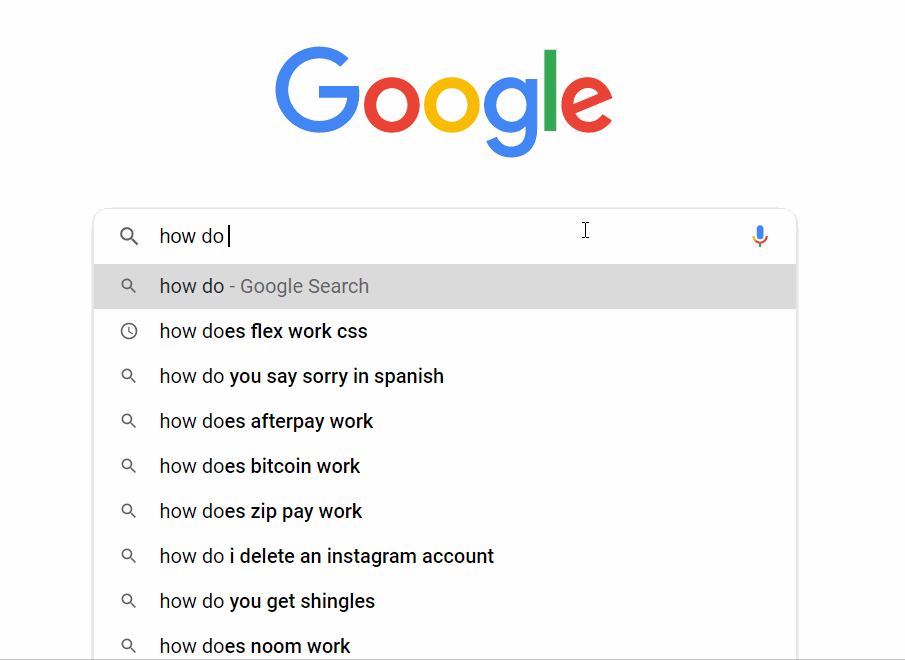
Use THIS Strategy to Get More Listeners for Free
Learn an easy way to can grow your audience for free
Step Three: Identify your main marketing channels
Now that you know who your ideal listeners are, you need to figure out where they hang out. These places will form the channels where you start promoting your content.
Now, you don’t have all the time and money in the world, so you need to make sure to make the most of what you have. So, picking the channels where your audience hangs out is going to be a key to getting your content out there and helping you grow.
There are multiple marketing channels at your disposal. The good news is, there are some great ways to start building an audience for free or next to nothing on most of these channels.
Want to do more with your video podcasts? Use the Video to text converter to transcribe your podcasts, generate subtitles automatically and even edit them using text!
Step 5: Repurpose your podcast!
Unfortunately, a lot of people and businesses are fighting for attention. At the time of writing this, there are over 700,000 podcasts on Spotify alone! That means you too will fight for attention. It also means that your listeners may not just come knocking on your door. You have to get in front of them.
Build it and they will come – is not that true.
You never know where your next listener, connection, sponsor or fan could come from – so, cast a wide net. You can do this by repurposing your content and distributing it across multiple channels.
Although it takes time, effort and a bit more creativity, it’s well worth it in the long run -especially as your content garners more likes, shares, listeners, subscribers, and loyal fans. The good great thing about running a podcast? You have ample content ready to spin into refurbished creative content. There are a several ways to repurpose your content, but don’t let the following ideas limit you – think outside the box to see how you can make use of your current content.
- Write ‘show notes’ for your podcast
- Embed your transcript on your website, along with the full video or podcast on the same page.
- Record your podcasts as videos – so you can push to YouTube first
- If you haven’t recorded in video format turn your full audio-only podcasts into video
- Turn podcasts into bite size audio grams for Instagram
- Clip the best parts of your long video interview into bite size videos for social media
- Turn your transcript into a long form blog post.
- Edit your video into 30 second clips for TikTok (make sure they are in story format i.e. aspect ration should be 9:16)
- Grab valuable (inspirational) quotes from your content and turn them into images for social media
- Use the theme of your podcast episode and turn that into mini TikTok teasers or value-bombs
- Do a ‘best-of’ video – take the best bits from various episodes and post as a separate episode/YouTube video

This Tool Helps You Become a Content Creating Machine
Double your audience by turning your video podcasts into content for social – fast and simple.
Step 5: Spread the word
Just posting onto your social media is not enough to start drawing more listeners. You need to actively promote and share your content.

Here are a few things you can do:
- If you have guests on your show – ask them to share it with their audience
- Send an email to your audience on every episode release (you should always be growing your email list!)
- Share on your personal Facebook profile and page (yes, set one up if you haven’t already)
- Message your (relevant) friends* and contacts – don’t spam them on every episode release
- Use comments wisely on social media: Most time users will post their problems to social media, stay on the look out for these in various groups, share the relevant podcast or bite-size content that you know solves the problem mentioned in that post
🔥 Tell EVERYONE to share! Bit of shameless plug every now and then doesn’t hurt anyone…. (just don’t get banned in community groups)
*Don’t rely on family and friends to do the hard work for you. Unless they fall into your target audience, if anything it’ll just give them a reason to ask to be a guest on your show instead – yeah…you don’t want that.